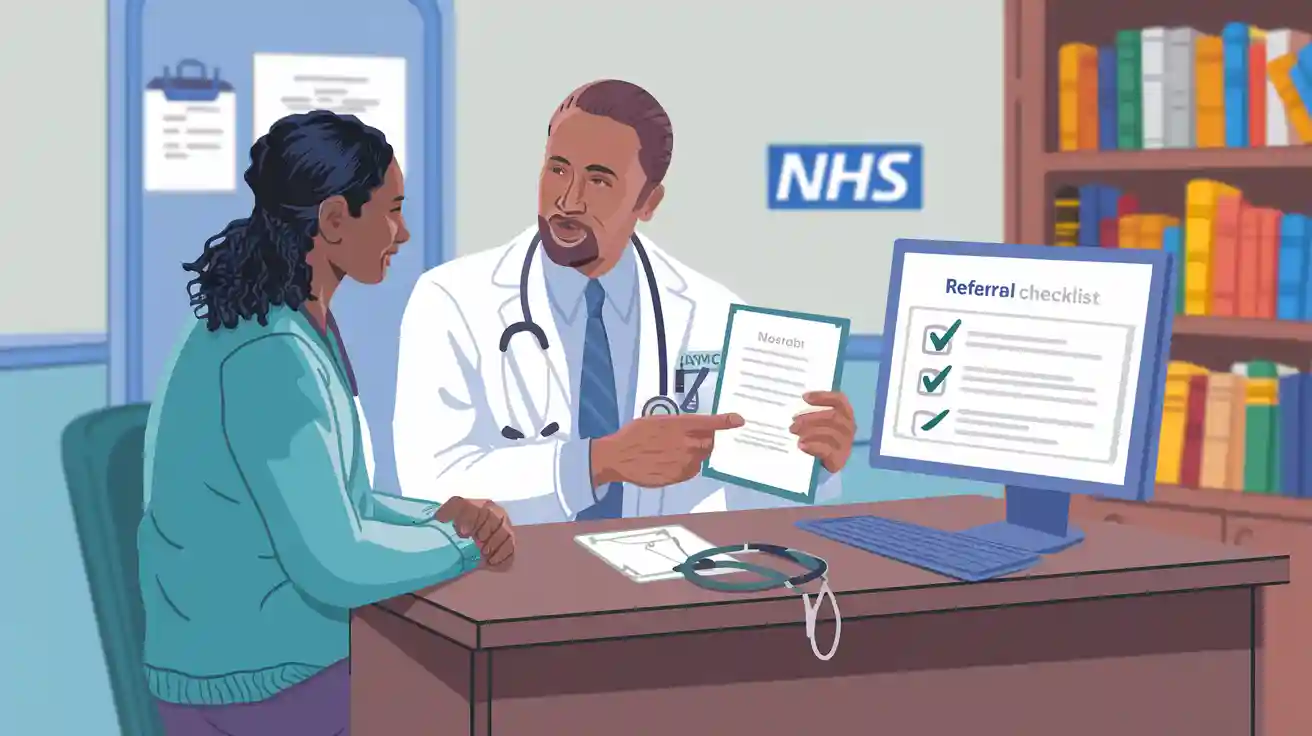A simple guide to referral in review in the NHS

Referral in review describes the stage when a specialist checks a patient's referral to ensure it matches the right service. NHS England reports show that nearly half of urgent suspected cancer cases follow this process. This careful step helps patients reach the correct care pathway without unnecessary delays.
Key Takeaways
Referral in review ensures patients are directed to the right specialist quickly, avoiding unnecessary delays and appointments.
Specialists check referrals for accuracy and suitability, helping the NHS use resources wisely and improve patient care.
Digital systems like the NHS e-Referral Service track referrals closely, keeping patients informed and making the process more efficient.
Referral in Review Explained
What It Means
Referral in review describes the stage when a healthcare professional checks a referral before it reaches a specialist. In the NHS e-Referral Service, this step helps ensure that each patient is directed to the most suitable clinic or service. A clinician, such as a consultant or specialist nurse, examines the details provided by the GP. They look at the patient’s symptoms, medical history, and the reason for the referral. If the referral does not match the right service, the clinician can redirect it to a more appropriate team. This process helps patients avoid unnecessary appointments and ensures they see the right expert as soon as possible.
The NHS e-Referral Service, sometimes called "Choose and Book," has made this process more efficient. It reduces paperwork and helps prevent duplicate referrals. In some international systems, similar electronic referral processes have tripled productivity and cut waiting times.
Why Referrals Are Reviewed
Reviewing referrals is important for several reasons. It helps make sure that patients receive care that matches their needs. It also supports the NHS in using its resources wisely. When clinicians review referrals, they check if the request is clinically appropriate and if the patient will benefit from seeing a specialist. They also look for missing information or signs that a different service might be better.
NHS guidelines and clinical evidence support this review process. These guidelines help clinicians make decisions based on the best available research and patient data. The review process also encourages doctors to improve their referral practices through feedback and education.
GPs’ decisions on referrals affect both patient care and NHS resources, so reviewing these decisions helps balance clinical needs and costs.
Referral rates can vary widely between doctors and practices, so reviewing helps identify and address these differences.
Without clear standards, some referrals may be unnecessary, while others may be missed, which can delay diagnosis or treatment.
Patient data, such as referral rates and unmet needs, show where improvements are needed.
The NHS faces financial pressures, so referral in review helps maintain quality while managing costs.
Educational programmes based on referral reviews have improved how doctors refer patients and led to better outcomes.
After referral management began, the NHS saw more referrals but shorter waiting times and fewer duplicates. Peer review also improved the quality of referrals and reduced unnecessary ones.
Who Reviews Referrals
Different healthcare professionals take part in the referral in review process. GPs act as gatekeepers, deciding when a referral is needed. Once a referral is made, consultants, specialist nurses, or allied health professionals may review it. Some practices use structured referral forms or require a second opinion before sending the referral. Educational sessions led by consultants can also help GPs improve their referral decisions.
Primary care doctors start the process by identifying patients who need specialist care.
Consultants and specialist nurses review referrals to check for accuracy and appropriateness.
Allied health professionals, such as physiotherapists, sometimes help decide if a referral is needed.
Organisational changes, like adding a second opinion or using structured forms, have improved referral quality.
Financial incentives have had mixed results, but active education and teamwork have shown positive effects.
Specific Metrics / Data Sources | Relevance to Clinician Assessments During Referral and Review Processes | |
|---|---|---|
Adverse Events | Hospital admissions, A&E attendances | Shows how referral decisions affect patient safety and NHS use |
Patient Physical Health Safety | Physical health events, mortality | Reflects how clinician review improves safety and outcomes |
Clinical Effectiveness Metrics | Diabetes control (HbA1c) | Indicates better management of long-term conditions |
Healthcare Utilisation Data | Number and length of hospital stays, A&E visits | Measures changes in NHS resource use |
Clinical Time | Time spent on referrals and calls | Shows how clinician review affects workload and efficiency |
Economic Impact | Cost estimates and savings | Assesses value for money and cost-effectiveness |
Unintended Consequences | Uptake of health monitoring, spill-over effects | Captures wider effects of referral review |
Data Sources | Electronic patient records, hospital statistics, clinician surveys | Provides reliable data for measuring impact |
The Referral Process
How the Review Works
The referral in review stage begins after a GP or primary care clinician sends a referral for specialist care. A specialist or trained reviewer examines the referral details. They check the information for accuracy, completeness, and clinical need. If the referral lacks important details, the reviewer may request more information from the GP. The reviewer also decides if the patient should see a specialist or if another service would be more suitable.
The NHS uses many indicators to measure how well this process works.
Over 240 unique metrics help track referrals, such as how often referrals happen, why they are made, and how quickly patients get appointments.
Most metrics focus on the structure of referrals, like how forms are filled out and how information is shared.
Other metrics look at the process, such as how quickly referrals move through the system, and outcomes, like patient satisfaction.
Data comes from questionnaires, hospital records, and chart reviews.
Monthly statistics show that waiting times for treatment can change. For example, waiting times rose during the COVID-19 pandemic but have started to fall again.
The NHS uses these measures to improve the referral in review process and make sure patients get timely care.
Redirection to Other Services
Sometimes, the reviewer decides that a different service would better meet the patient's needs. This redirection can happen for several reasons. The referral might not match the specialist’s area, or another service could provide faster or more appropriate care. Digital platforms now help with this process. For example, one digital referral platform saw a 44% rate of redirection, which improved how patients accessed care.
Redirection helps avoid unnecessary appointments and ensures patients see the right expert.
Reviewers document reasons for redirection, such as missing information or a better-suited service.
Some systems have seen higher acceptance rates for referrals made by professionals, showing better decision-making.
Even when referrals are rejected or redirected, patients are not left without support. They receive information about other services or resources.
Referral management centres use databases to guide redirection, but their effectiveness varies. Some studies show that these centres can cause delays or errors if not managed well. The NHS continues to look for ways to improve this part of the process.
The e-Referral Service Worklist
The NHS e-Referral Service (e-RS) manages referrals using a digital worklist. This system tracks each referral from start to finish. The worklist shows the status of every referral, such as waiting for review, accepted, redirected, or needing more information.
Electronic dashboards help staff spot delays and follow up with hospitals or clinics.
Whole-practice use of tracking software leads to better completion of referral forms and fewer rejected referrals.
The dashboard feature allows staff to see which patients are waiting for appointments and take action if there are delays.
The e-RS provides an audit trail, so every step is recorded and can be checked if needed.
Referral Status | Description | Action Taken |
|---|---|---|
Waiting for Review | Referral sent, not yet checked by specialist | Specialist reviews details |
Accepted | Referral approved for specialist appointment | Patient receives appointment info |
Redirected | Sent to a different service or specialist | Patient informed of new pathway |
More Info Needed | Reviewer requests extra details from GP | GP provides missing information |
Rejected | Referral not accepted, with reason given | Patient and GP receive explanation |
The e-RS worklist helps prevent referrals from being lost or delayed. However, problems can still occur. Sometimes, no appointment slots are available, so referrals wait in a queue. Technical issues, such as software bugs or outages, can also cause delays. Good management of the worklist is important to keep the process running smoothly.
Patients can expect updates from their GP or the hospital during the referral in review stage. If there are delays, staff use the worklist to follow up and keep patients informed.
Patient Rights and Next Steps
Choosing a Service
Patients in the NHS have the right to choose which hospital or clinic they attend for specialist care. This choice empowers them and often leads to higher satisfaction and better health outcomes. Studies show that when patients take part in decisions about their care, they feel more engaged and follow treatment plans more closely. NHS policies now support this approach, moving away from a system where doctors made all the decisions. Patients can use online tools like NHS Choices to compare hospitals and services. These platforms provide information about waiting times, quality ratings, and available treatments. Some patients may find the amount of information overwhelming, but staff and digital tools help guide them through the process.
Tracking Your Referral
The NHS has improved how it tracks referrals. Before recent changes, only about 35% of patients had referrals properly documented. After new systems were introduced, this number rose to 88%. The percentage of referrals with clear evidence also increased from 83% to 100%. These improvements mean fewer patients get lost in the system. Electronic referral systems now allow staff to monitor each step, spot delays, and keep patients informed. A study in Wales found that 81% of electronic referrals were processed within one hour, and GPs reported high satisfaction. However, problems can still occur, such as missed appointments or late communications. Staff use process analytics to find and fix these issues, making sure patients move smoothly through the system.
What Happens After Review
After the review, patients receive information about their next steps. If the referral is accepted, the patient gets an appointment with the right specialist. If redirected, the patient learns about the new service or clinic. Follow-up is important for good outcomes. Data shows that patients who receive follow-up contact after discharge have lower rates of emergency readmission. For example, one group with follow-up had a 9.24% readmission rate, compared to 15.67% for those without contact. Staff may call patients, arrange home visits, or refer them to other services like pharmacists or mental health nurses. This support helps patients recover and reduces the chance of problems after leaving hospital.
The referral in review process helps patients reach the right care. Studies show small improvements in hospital quality, but results vary.
Public reporting can drive quality when trusted authorities lead.
Patient involvement shapes better outcomes. Patients can ask their GP for updates or visit the NHS website for more support.
FAQ
What should a patient do if they have not heard about their referral?
Patients can contact their GP surgery for updates. Staff can check the referral status on the NHS e-Referral Service and provide information.
Can a patient choose a different hospital after the referral review?
Yes, patients can request a different hospital or clinic. The NHS e-Referral Service allows them to compare options and make a new choice.
How long does the referral in review process usually take?
Most referrals are reviewed within a few days. Some may take longer if more information is needed or if specialist advice is required.
See Also
A Clear Overview Of The NHS Referral Process
Typical Waiting Times For Doctor Referrals Across The UK
Complete Guide To NHS Waiting Periods And Expectations

